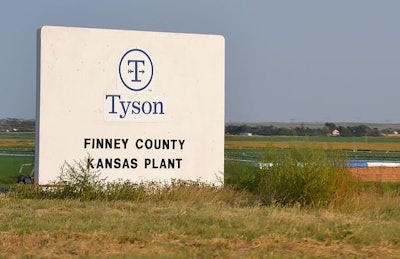
Tyson Foods’ net income nearly doubled during the fourth quarter of fiscal year 2020 when compared to the fourth quarter of 2019, while also increasing moderately for the full year.
The diversified protein company released its annual financial results, for the year ending October 3, on November 14.
Tyson’s net income for the fourth quarter was $695 million, up from the net income of $372 million from the fourth quarter of 2019. For the full year, Tyson’s net income was $2.15 billion, up from the 2019 figure of $2.03 billion.
“Our business performed well and delivered strong fourth quarter and full-year results,” said Dean Banks, president and CEO of Tyson Foods. “Our team members, agricultural partners, and customers have shown resilience. This has enabled us to maintain and accelerate our efforts to provide global consumers with a safe and accessible food supply.”
The company also saw its sales increase for the full year, with the 2020 figure reaching $43.19 billion. Tyson’s sales for 2019 amounted to $42.01 billion. For the quarter, sales increased to $11.46 billion from $2.03 billion. The fourth quarter of 2020, however, contained one more week than the fourth quarter of 2019.
COVID-19 impact in 2020
Tyson Foods incurred direct incremental expenses associated with the impact of COVID-19 totaling approximately $200 million and $540 million for the fourth quarter and twelve months of fiscal year 2020, respectively.
These direct incremental expenses primarily included team member costs associated with worker health and availability and production facility downtime, including direct costs for personal protection equipment, production facility sanitization, COVID-19 testing, donations, product downgrades and rendered product, partially offset by CARES Act credits. Other indirect costs associated with COVID-19 are not reflected in this amount, including costs associated with raw materials, distribution and transportation, plant underutilization and reconfiguration, premiums paid to cattle producers and pricing discounts.
Performance by segment
Beef - Sales volume increased 11.8%, or increased 3.8% after removing the impact of an additional week, for the fourth quarter of fiscal 2020 primarily due to a fire that caused the temporary closure of a production facility during the fourth quarter of fiscal 2019.
Sales volume decreased 4.5%, or decreased 6.5% after removing the impact of an additional week, for fiscal 2020 due to lower production throughput associated with the impact of COVID-19 during portions of fiscal 2020 and a reduction in live cattle harvest capacity as a result of a fire that caused the temporary closure of a production facility for the majority of the first quarter of fiscal 2020.
Average sales price decreased in the fourth quarter of fiscal 2020 associated with increased availability of live cattle supply and lower livestock cost. Average sales price increased in fiscal 2020 as beef demand remained strong amid supply disruptions related to the impact of COVID-19.
Operating income increased primarily due to market conditions, including COVID-19 disruptions, which increased the spread between preexisting contractual agreements and the cost of fed cattle, and the impact of an additional week in fiscal 2020, partially offset by price reductions offered to customers, as well as production inefficiencies and direct incremental expenses related to COVID-19. Additionally, the fourth quarter of fiscal 2019 was impacted by $31 million of net incremental costs from the production facility fire.
Pork - Sales volume increased 15.2%, or increased 6.9% after removing the impact of an additional week, for the fourth quarter of fiscal 2020 due to strong demand for pork products and increased domestic availability of live hogs. Sales volume increased 1.8%, or decreased slightly after removing the impact of an additional week, for fiscal 2020, due to strong demand for Tyson pork products and increased domestic availability of live hogs, offset by lower production throughput associated with COVID-19 during portions of fiscal 2020.
Average sales price in the fourth quarter of fiscal 2020 decreased associated with lower livestock costs. Average sales price in fiscal 2020 increased as pork demand remained strong amid supply disruptions related to the impact of COVID-19, partially offset by lower livestock costs.
Operating income increased primarily due to market conditions, including COVID-19 disruptions, which increased the spread between preexisting contractual agreements and the cost of live hogs, and the impact of an additional week in fiscal 2020, partially offset by production inefficiencies and direct incremental expenses related to COVID-19.
Chicken - Sales volume increased 1.9%, or decreased 5.4% after removing the impact of an additional week, for fourth quarter of fiscal 2020, and increased slightly, or decreased 1.7% after removing the impact of an additional week, for fiscal 2020 primarily due to lower production throughput associated with the impact of COVID-19 during portions of fiscal 2020 and lower foodservice demand, partially offset by increased retail demand.
Average sales price decreased primarily due to weaker chicken pricing as a result of market conditions. Operating income decreased primarily from market conditions, unfavorable product mix, as well as production inefficiencies and direct incremental expenses related to COVID-19. Operating income was also impacted by approximately $45 million of net derivative gains in the fourth quarter of fiscal 2020 and approximately $70 million of net losses in the fourth quarter of 2019, in addition to approximately $50 million of decreased feed ingredient costs in the fourth quarter of fiscal 2020 as compared to the fourth quarter of fiscal 2019. For fiscal 2020, net derivative results and feed ingredient costs were relatively flat as compared to fiscal 2019. Operating income was further impacted by $34 million and $21 million in restructuring costs incurred in fiscal 2020 and fiscal 2019, respectively.
Prepared Foods - Sales volume increased 1.6%, or decreased 5.6% after removing the impact of an additional week, for fourth quarter of fiscal 2020, and decreased 1.9%, or decreased 3.7% after removing the impact of an additional week, for fiscal 2020 as growth in volume across the retail channel was offset by a reduction in the foodservice channel related to reduced demand and lower production throughput due to the impact of COVID-19 during portions of fiscal 2020.
Average sales price increased in the fourth quarter and for fiscal 2020 due to favorable product mix associated with the surge in retail demand, and for fiscal 2020, the pass through of increased raw material costs.
Operating income increased in the fourth quarter of fiscal 2020 due to favorable product mix associated with strong demand for retail products and the impact of an additional week, partially offset by the impacts of reduced foodservice sales. Operating income decreased in fiscal 2020 primarily due to increased operating costs, including a $105 million increase in net raw material costs and derivative losses, as well as production inefficiencies and direct incremental expenses related to COVID-19, partially offset by reduced promotional spend. Operating income was also impacted by $28 million and $18 million in restructuring costs incurred in fiscal 2020 and fiscal 2019, respectively. Additionally, operating income in the fourth quarter of fiscal 2019 was further impacted by a $41 million impairment from a planned divestiture of a business.

















